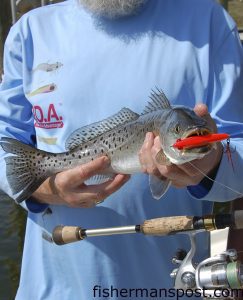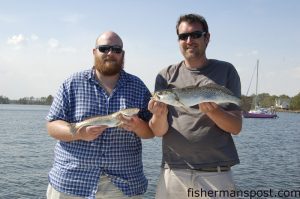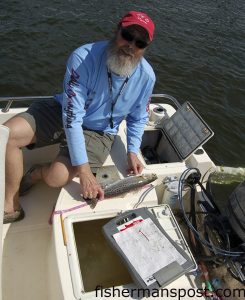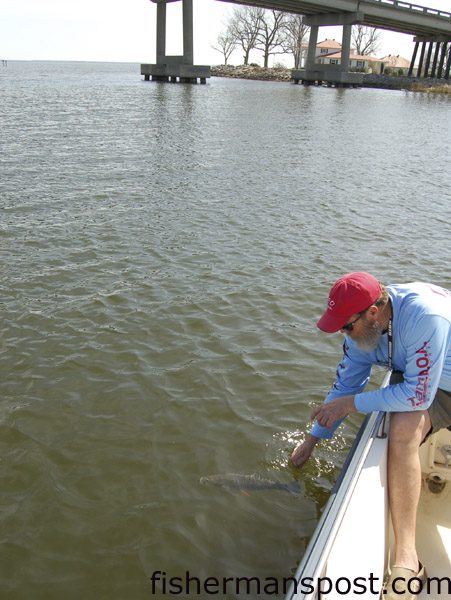Speckled And Tagged

This 3 lb. Neuse River speckled trout fell for an custom orange MR17 MirrOlure made specially for Capt. Dave Stewart of Minnesott Beach Bait and Tackle.
“We’re going to head over to Oriental first,” Capt. Dave Stewart said as his 19’ Key West Bay Reef idled away from the ramp at the Minnesott Country Club. Easing out into the Neuse River and past the ferry connecting Minnesott Beach with Cherry Branch, he put the bay boat on plane and continued explaining our fishing plan for the day.
“There have been some bigger 18-20” trout over that way,” the captain, who operates Minnesott Beach Bait and Tackle and Knee Deep Custom Charters out of this small community occupying a point on the lower Neuse River. “See that bridge over there to the left? That’s Dawson’s Creek, and there have been bunches of little trout up over that way. We’ll come back and do some tagging with them later.”
Dave is one of several Carolina speckled trout sharpies that NC State’s Tim Ellis has tapped to be part of a multi-year trout tagging program, and the captain rarely leaves the dock without an aluminum binder carrying his tagging supplies.
Along for his first Guide Time trip, Fisherman’s Post’s new Sales Manager Joshua Alexander and I had enjoyed a leisurely drive up from Wilmington, through New Bern, and then down the sleepier roads of Pamlico County to meet up with Dave at noon. He’d relayed the news that the bite had been better in the afternoon the week before our trip, and I believe both of us were excited (perhaps relieved) not to have to crawl out of bed at 3:00 AM to make it to Minnesott by sunrise.
Detailing the shoreline landmarks and relevant Pamlico County history/gossip, Dave was soon pulling back the throttle and idling towards a collection of docks hosting a mix of commercial vessels, sailboats, and pleasure cruisers along the Oriental waterfront.
“We’ll fan cast the area right here,” Dave explained, gesturing up a channel between docks as he lowered his trolling motor. “There are some humps on the bottom here, and once we find the fish, we’ll plop down.”
The captain handed each of us a Daiwa/TFO spinning outfit equipped with a Yo-Zuri 3D Fingerling Minnow and grabbed a rod with a soft D.O.A. jerkbait for himself.
“Y’all have used braid right?” he asked with a grin as we started casting. “You know not to get it knotted up? Don’t make me holler at you.”
The ‘whick’ of braid flying quickly through guides and the beep/whir of the trolling motor replaced the hum of the outboard, and we began working our way between the rows of boats lining the passage.
“Work that 3D with a couple of twitches and then a pause,” Dave said, giving a quick demonstration, “and be ready when you stop it—they’ll snatch the snot out of it! I’d say the majority of the time they grab it on the pause.”
Despite an earlier explanation of why he prefers hard plastic lures to the soft “rubber” baits, it was less than five minutes before Dave snapped up his rodtip to the clear headshakes of a speckled trout. A minute later, the 15” fish was flopping in the landing net.
“Sometimes the rubber works better,” Dave said, holding the trout gingerly for a photo. “Usually in the summer. Gary (Dubiel, friend and fellow guide) and I fish together, and sometimes he’ll start popping them on the rubber and I’ve got to switch over.”
Determining that this fish was very much a “tagger” (fish have to be over 12” and in good condition to get a tag), the captain wasted no time getting the feisty speck into the livewell.
Combatting a little needling about catching the first fish on the rubber and whether or not we all needed to switch over, Dave told us to keep casting the hard plugs, although he handed me a rod with a MirrOlure MR17 tied on to replace the Yo-Zuri.
“That orange color, it’s all mine! They make it special for me, and I’m the only one who’s got it,” he said as we traded sticks. “The MirrOlure fishes a little deeper than the 3D. Let it sink down a good bit before you start working it.”

Fisherman's Post Sales Manager Joshua Alexander and the author with a pair of Neuse River speckled trout that fell for Yo-Zuri 3D Fingerling Minnows cast to a dock near Oriental while they were fishing with Capt. Dave Stewart of Knee Deep Custom Charters.
After briefly examining the orange-backed, gold-sided lure, I began casting, following Dave’s instructions to let the lure get down in the water a bit before beginning the erratic twitch-pause retrieve. Whether I was doing a good job or just encountered a ravenous fish I wasn’t sure, but I set the hook to my own set of head shakes on just the third cast with the MirrOlure.
“I think I like this color, Dave,” I allowed as I worked the fish to the boat.
It was a little smaller than Dave’s first fish, but as I slid it into the net he assured me it, indeed, was also a tagger, so into the livewell it went, joining his trout in what I began to think of as the waiting room for the minor medical procedure in these trout’s future.
I decided I definitely liked the orange MR17 two casts later, as what was clearly a bigger fish “snatched the snot” out of the MirrOlure a few twitches into my retrieve.
“Whoa, that’s a better one,” I exclaimed as the fish objected to its current situation, thrashing on the surface before allowing me to gain a little line.
“Keep your rod tip down so he doesn’t throw it,” the captain coached as the bright orange lure extending from the speck’s mouth highlighted another round of splashy head shakes.
The TFO rod telegraphed a few more thrashes that we couldn’t see, and the speck threw in a little side-to-side wallowing, but Dave soon extended the landing net and pulled the fish over the gunnel. This was a solid three pounder, one of the 18-20” fish we’d come to Oriental after, and we were thrilled to have it in the boat, especially Dave, who wanted some photos of the custom MirrOlure in the speck’s mouth to send to a buddy who’d been doubting the color combo.
The vivid lure against the backdrop of the speck’s fanged yellow mouth made for a great photo, and hooked gently, the fish was also an ideal candidate for tagging.
“Josh, take that MirrOlure away from him and catch one!” Dave exclaimed after the larger fish joined the patient pair in the “waiting room.”
I passed the rod off to the salesman, but unfortunately for him, he’d only fired one cast when a large lobster yacht made its way past us in the channel.
“On that note, we’re going to ease on out of here,” Dave said, convinced the boat’s loud diesel shut down our bite. “That’s okay. We’ve got more fish to catch.”
Along with Capt. Gary Dubiel, Dave is part of a network of other Neuse River guides and anglers who share information on what’s biting when and where.
“Gary was out bird-dogging for us this morning,” he explained, “and my future son-in-law is out in one of my boats now. We’ve got so much water to cover around here; it goes a long way to have other people helping out. This time of year, we could be fishing stripers and shad all the way up to Goldsboro or looking for trout in Turnagain Bay. That’s a big area.”
Easing up Oriental’s Smith Creek, Dave positioned us on another shoreline, but soon determined that with lower water in this spot and plenty of the slimy winter algae still on the bottom, we should head for greener (or in this case, less green) pastures. We paused near the high-rise bridge at Oriental for Dave to demonstrate the tagging process.
After gently pulling one of the smaller fish from his livewell, he talked us through the process.

Capt. Dave Stewart prepares to tag a Neuse River speckled trout that fell for an MR17 MirrOlure near a dock in Oriental.
“The first thing is recording an accurate length,” Dave explained, laying the speck on a measuring board. “This one’s 14.25 inches.”
Producing a scalpel from his tagging kit, he continued. “Then we make a small incision just through the skin behind the pectoral fin, but don’t go deep enough to hit the gut.”
A small yellow “spaghetti” tag with a T-shape head is then inserted in the incision and twisted to lock it in place.
“That tag number identifies this as a 14-inch fish that was caught here,” Dave went on, noting the GPS coordinates and the date alongside the tag number in his logbook.”
He followed the same program with our other fish, but with a few twists. One 13” fish got two tags, and the 18.5” three pounder received a red tag instead of a yellow one.
“If somebody catches the double-tagged one and it’s only got one tag, then that helps Tim figure out the rate of lost tags. We put that red $100 tag in the pretty fish.”
The standard tags reward anglers with either $5 or a Trout Tagging Program hat, but anyone recapturing the red-tagged fish earns a cool $100 on top of the less tangible rewards of catching a nice speck. I asked if one could opt for 20 hats instead of the Benjamin, but Dave said they’d have to take that up with Tim.
The trout tagging project is in its final year, and it’s already revealing some interesting things about trout movement and growth.
“We had one fish tagged in August at Oregon Inlet five months ago that was caught last week in Dawson’s Creek,” Dave revealed when I asked about recaptures. “It was 12 inches when they tagged it and 17 inches last week”
While I marveled that an inch a month seemed like a pretty solid growth rate, Dave told me Tim’s research had shown they can double that during heavy feeding in the summer months.
After sending our tagged fish happily on their way, we got back to fishing, casting the Yo-Zuris again along a nearby shoreline punctuated by a few scattered docks.
Our first few casts were unproductive, and Dave had us refocus our efforts.
“The fish are in this deeper water out off the shore,” he explained, gesturing to the 4-6’ areas where the boat was positioned, “so that’s where you want to cast, not up to the shore. That’s something you get when you take bass fishermen trout fishing a lot—you just can’t keep those guys from casting to the bank.”
Quickly switching our aim from the bank (who wants to be compared to a bass fisherman?), we started hooking up with specks within five minutes.
Joshua had still yet to hook one, though, and as I reeled in a spike trout around 13”, Dave figured out why.
“You’ve got to take the slack out of the line after you twitch that bait,” he coached, offering a demonstration with his own rod. “If you don’t, you’ll never feel them bite. When we’re throwing the rubber for stripers up at New Bern, a lot of times we’ll see the bites before the clients feel them and tell them to set the hook. They’ll spit these hard baits out in a hurry, though, so you’ve got to hook’em quick.”
Again, Dave had offered seemingly simple, but not necessarily common sense, advice and Joshua quickly put an exclamation point on it. Just after I set the hook on a fat trout, Josh was about to set his rod down and grab the camera (what a good guy), but Dave urged him to keep casting.
Two twitches (and no slack) into that very cast, he set the hook, and we had a double header! We got both fish to the net and happily posed for a doubleheader photo while Dave snapped away.
Recalling our original plan and the fading afternoon, the captain asked, grinning, if we still wanted to go to Dawson’s Creek and tag the little guys.
We were averaging a fish every few minutes along this shoreline and with several between 18-21” mixed in with the spikes, the answer was a hearty no. We’d already seen the tagging process, and there’s some kind of saying about leaving fish to find fish (all the more poignant when leaving big fish for little ones), so we were happy to fish out our time where we were.

Capt. Dave Stewart gingerly releases a speckled trout bearing a $100 red tag near the high rise bridge at Oriental.
We continued catching fish until Dave decided it was time to head for Minnesott so Joshua and I had time to catch the ferry back across the river instead of backtracking to New Bern. His timing is apparently exquisite, as we caught fish until we left and made the ferry with one minute to spare.
If catching a lot of speckled trout in a beautiful, quiet location with a captain full of local knowledge and lore sounds like a good time to you, it’s time to investigate a trip with Capt. Dave Stewart and Knee Deep Custom Charters. As his website touts, the “trash talking is free,” and will keep anglers grinning and on their toes.
In addition to trout, Dave pursues striped bass (“rockfish” locally) around New Bern, and flounder and red drum in the lower Neuse. Give him a call at (252) 670-2841 to talk about a trip, or visit www.pamlicotackle.com for more information about Knee Deep and Minnesott Beach Bait and Tackle.
